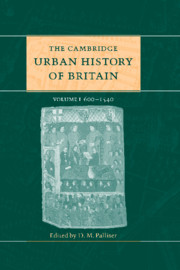Book contents
- Frontmatter
- Part I Introductory
- Part II The early middle ages 600–1300
- Part III The later middle ages 1300–1540
- 12 General survey 1300–1540
- 13 Government, power and authority 1300–1540
- 14 The economy of British towns 1300–1540
- 15 Urban culture and the Church 1300–1540
- 16 The built environment 1300–1540
- 17 London 1300–1540
- 18 The greater towns 1300–1540
- 19 Port towns
- 20 Small towns 1270–1540
- Part IV Regional surveys
- Part V Conclusion
- Appendix: Ranking lists of English medieval towns
- Select bibliography
- Index
- References
18 - The greater towns 1300–1540
from Part III - The later middle ages 1300–1540
Published online by Cambridge University Press: 28 March 2008
- Frontmatter
- Part I Introductory
- Part II The early middle ages 600–1300
- Part III The later middle ages 1300–1540
- 12 General survey 1300–1540
- 13 Government, power and authority 1300–1540
- 14 The economy of British towns 1300–1540
- 15 Urban culture and the Church 1300–1540
- 16 The built environment 1300–1540
- 17 London 1300–1540
- 18 The greater towns 1300–1540
- 19 Port towns
- 20 Small towns 1270–1540
- Part IV Regional surveys
- Part V Conclusion
- Appendix: Ranking lists of English medieval towns
- Select bibliography
- Index
- References
Summary
Measured in terms of their populations, twenty or so towns emerge as important provincial centres with some 2,000 taxpayers in 1377. To these must be added Exeter, which doubled in size during the fifteenth century to emerge as the third largest provincial town in 1524–5, and Edinburgh, whose population was growing towards c. 12,500 by 1560 (see Table 18.1). York alone achieved a size or status comparable to large European towns such as Antwerp, Bremen or Lyon. Most of the greater towns of Britain were distinguishable from market towns by the scale and intensity of their urbanity: physical size and appearance, complex internal economic and social structures, sophisticated government and regional significance. Even so, few enjoyed the close formal interdependence of a large Italian, French or German town with its contado or umland. In Britain, administration outside urban liberties commonly remained subject to the crown. Coventry, Gloucester and York were exceptions: Coventry by acquiring some 15,000 acres of the manor of Coventry, Gloucester through its incorporation of thirty or so villages in 1483, and York as the result of its jurisdiction over an adjacent rural wapentake, the Ainsty.
Population size in 1377 reflected the economic vitality of towns which had recovered from the depredations of the Black Death. Though population losses varied, it is likely that many of the greater towns lost a third to a half of their inhabitants between 1348 and 1349. Some, like Boston and Winchester, were already beyond their most successful phase by 1348–9 and retained their rank on the strength of earlier prosperity.
- Type
- Chapter
- Information
- The Cambridge Urban History of Britain , pp. 441 - 466Publisher: Cambridge University PressPrint publication year: 2000
References
- 4
- Cited by



